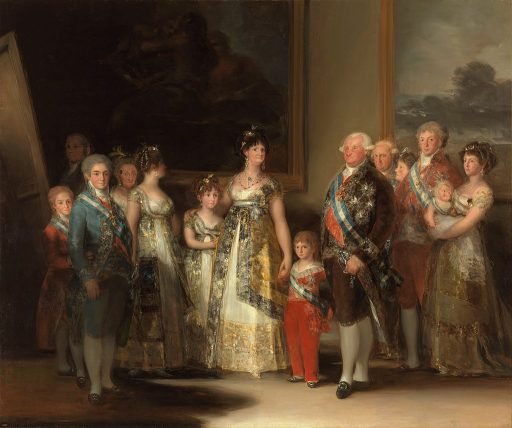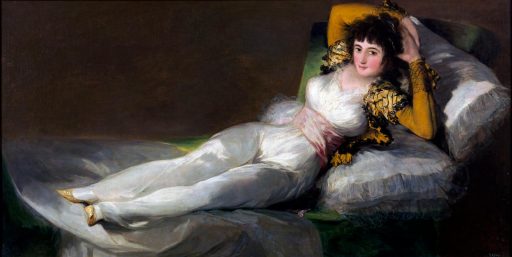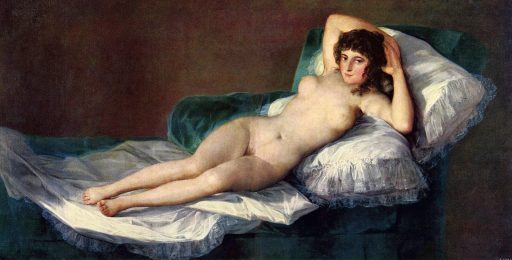SWG Kunstlexikon
FRANCISCO DE GOYA
KUNSTWERKE FRANCISCO DE GOYA

Francisco de Goya | Die Familie Karls IV | 1800 – 1801 | Öl auf Leinwand | 280 cm x 336 cm | Museo del Prado | Aus Wikimedia Commons, dem freien Medienarchiv | Dieses Werk ist gemeinfrei, weil seine urheberrechtliche Schutzfrist abgelaufen ist

Francisco de Goya | Die bekleidete Maja | 1800 -1807 | Porträt | Öl auf Leinwand | 95 cm x 190 cm | Museo del Prado | Aus Wikimedia Commons, dem freien Medienarchiv | Dieses Werk ist gemeinfrei, weil seine urheberrechtliche Schutzfrist abgelaufen ist

Francisco de Goya | Die nackte Maja | 1795 – 1800 | Akt | Öl auf Leinwand | 97 cm x 190 cm | Museo del Prado, Madrid | Aus Wikimedia Commons, dem freien Medienarchiv | Dieses Werk ist gemeinfrei, weil seine urheberrechtliche Schutzfrist abgelaufen ist
Francisco de Goya | A collection of 289 paintings | LearnFromMasters |
Description: „Francisco de Goya (30 March 1746 – 16 April 1828) was a Spanish romantic painter and printmaker. He is considered the most important Spanish artist of late 18th and early 19th centuries and throughout his long career was a commentator and chronicler of his era. Immensely successful in his lifetime, Goya is often referred to as both the last of the Old Masters and the first of the moderns. He was born to a modest family in 1746 in the village of Fuendetodos in Aragon. He studied painting from age 14 under José Luzán y Martinez and moved to Madrid to study with Anton Raphael Mengs. He married Josefa Bayeu in 1775; the couple’s life together was characterised by an almost constant series of pregnancies and miscarriages. He became a court painter to the Spanish Crown in 1786 and the early portion of his career is marked by portraits commissioned by the Spanish aristocracy and royalty, as well as the Rococo styletapestry cartoons designed for the royal palace. Goya was a guarded man and although letters and writings survive, we know comparatively little about his thoughts. He suffered a severe and undiagnosed illness in 1793 which left him completely deaf. After 1793 his work became progressively darker and pessimistic. His later easel and mural paintings, prints and drawings appear to reflect a bleak outlook on personal, social and political levels, and contrast with his social climbing. He was appointed Director of the Royal Academy in 1795, the year Manuel Godoy made an unfavorable treaty with France. In 1799 Goya became Primer Pintor de Càmara, the then highest rank for a Spanish court painter. In the late 1790s, commissioned by Godoy, he completed his La maja desnuda, a remarkably daring nude for the time and clearly indebted to Diego Velázquez. In 1801 he painted Charles IV of Spain and His Family. In 1807 Napoleon led the French army into Spain. He remained in Madrid during the Peninsular War, which seems to have affected him deeply. Although he did not vocalise his thoughts in public, they can be inferred from his „Disasters of War“ series of prints (although published 35 years after his death) and his 1814 paintings The Second of May 1808 and The Third of May 1808. Other works from his mid period include the „Caprichos“ and Los Disparates etching series, and a wide variety of paintings concerned with insanity, mental asylums, witches, fantastical creatures and religious and political corruption, all of which suggest that he feared for both his country’s fate and his own mental and physical health. His output culminates with the so-called „Black Paintings“ of 1819-1823, applied on oil on the plaster walls of his house the „Quinta del Sordo“ (house of the deaf man) where, disillusioned by domestic political and social developments he lived in near isolation. Goya eventually abandoned Spain in 1824 to retire to the French city of Bordeaux, accompanied by his much younger maid and companion, Leocadia Weiss, who may or may not have been his lover. There he completed his „La Tauromaquia“ series and a number of canvases. Following a stroke which left him paralysed on his right side, and suffering failing eyesight and poor access to painting materials, he died and was buried on 16 April 1828 aged 82. His body was later re-interred in Spain.“ | YouTube
FILM | VIDEO FRANCISCO DE GOYA
Goya | Crazy Like a Genius | moriundmori Kunst-Dokus | Film von Robert Hughes 2002 Written and Presented by Robert Hughes englisch mit deutschen Untertiteln Hofmaler, Satiriker, Kriegsberichterstatter und Topograf der eigenen Psyche: Der Spanier Francisco de Goya war zweifellos der schonungsloseste Chronist seiner Epoche. Der Film zeigt Meilensteine aus dem malerischen und grafischen Schaffen des kongenialen Künstlers, fesselnd präsentiert und kommentiert von Robert Hughes, einem der führenden Kunstkritiker und Goya-Spezialisten. Detailliert gibt er Einblicke in Goyas Wandlungsprozess, der nicht zuletzt geprägt war von Goyas Schreckensgespenstern, wie Krankheit, Inquisition, sozialen Missständen und menschlichen Abgründen. Documentary in which art critic Robert Hughes travels across Spain in search of the reality beyond the mythology of Spanish painter Francisco Goya. Goya has long been Hughes‘ favorite artist but has become a particular obsession since a near-fatal car accident left Hughes living with nightmares of Goya’s often dark and violent imagery. Written and presented by renowned art critic Robert Hughes, Crazy Like A Genius explores the world of Francisco Goya: charting his achievements as a court painter, satirist and war reporter, as well as a topographer of the inner self – of madness, fear and despair. This program offers a detailed visual and intellectual analysis of Goya masterpieces, including Witches in the Air, The Third of May and The Dream of Reason, as well as examples of his early work and portraiture such as The Duchess of Alba, The Nude Maja and The Clothed Maja. Hughes gives an insight into the enormous changes that took place in Goya s work in the course of his life: the shift from light to dark. In Spain, he travels to Goya s native Aragon and in Madrid he is seen visiting galleries, palaces and churches where Goya s works are on display. In New York Hughes calls on the American painter, Leon Golub, who shares his fascination for Goya, and elicits a contemporary artist s perspective on the Spanish master s work. Hughes professes himself incapable of summing up Goya s achievements neatly, but concludes that to meet Goya is still to meet ourselves. | YouTube
BIOGRAFIE FRANCISCO DE GOYA
GEBURTSJAHR | GEBURTSORT | TODESJAHR | 1828 | STERBEORT | Bordeaux Frankreich
AUSBILDUNG FRANCISCO DE GOYA
SAMMLUNGEN FRANCISCO DE GOYA
AUSWAHL
Uffizien | Florenz
Museo del Prado | Madrid
Museo Thyssen-Bornemisza | Madrid
Metropolitan Museum of Art | New York
National Gallery of Art Washington
AUSSTELLUNGEN FRANCISCO DE GOYA
EINZELAUSSTELLUNGEN
GRUPPENAUSSTELLUNGEN
WERKBESCHREIBUNG FRANCISCO DE GOYA
SCHWERPUNKTE / MEDIEN
Malerei | Drucke | Zeichnungen | Radierungen – Goya revolutionierte diese Technik durch das Hervorbringen von Kontrasten | Wandteppichentwürfe | Freskomalereien
STIL
Die rätselhaften, fantastisch-surrealen Darstellungen entlarven die Absurdität einer von Kriegsgräueln bestimmten Zeit.
THEMEN | MOTIVE | WERKE
Schrecken des Krieges | Menschen als Monster | Gleichnisse des Menschen | Darstellung des Grotesken | Angst | Zerbrechlichkeit | Leiden | Tod | Liebe | Porträts | Aktgemälde | Gefängnisse | Irrenhäuser | Stierkampfbilder | Bildergeschichten erzählen vom Traum und Wahnsinn der menschlichen Kreaturen und loten die Schönheit und den Schrecken des menschlichen Daseins aus
HAUPTWERKE
Die Erschießung der Aufständischen | 1814 | Museo del Prado | Madrid
Flug der Hexen
Los Caprichos = Launen
Schrecken des Krieges
Stierkampfzyklen La Tauromaquia
Pinturas Negras | Die schwarzen Bilder
DEFINITION | BESCHREIBUNG | MERKMALE
Werke erzählen vom Wesen des Menschen | deshalb erkennen wir uns in den Arbeiten von Franciso de Goya wieder | Bilder sind stets kritisch aufgeladen | dramatisch | düster | lustig | blanker Horror | flüchtige Striche bewirken in seinen Zeichnungen den größtmöglichen Ausdruck | durch Licht werden bestimmte wichtige Szenen hervorgehoben | gleichzeitige Anwesenheit von Licht und Dunkelheit
STICHWORTE FRANCISCO DE GOYA
spanischer Maler und Grafiker des ausgehenden 18. und frühen 19. Jahrhunderts. | viruose Zeichnungen | faszinierender Abbilder des Inneren | Theater der Gefühle | der erste Kriegsberichterstatter der Kunst | Vaterfigur der Kriegsfotografen | Erfassung des Wesens der Menschen | Goya hält uns Menschen einen Spiegel vor | Francisco de Goya ist der letzte der Alten Meister und der erste Maler der Moderne
ZITATE FRANCISCO DE GOYA
„Nadie se conoce – Niemand kennt sich selbst.“ | Francisco de Goya
„Wenn die Vernunft einschläft, erwachen die Dämonen.“ | Francisco de Goya
„Obschon die Nachahmung der Natur ebenso schwierig wie löblich ist, wenn sie dem Künstler gelingt, so ist doch auch der des Lobes wert, der sich ganz von ihr entfernt und den Augen Formen entdeckt, die bisher nur in seiner Phantasie bestanden haben.“ | Francisco de Goya
„Phantasie ohne Vernunft führt zu Ungeheuerlichkeiten; vereint aber bringen sie wahre Kunst hervor und schaffen Wunder.“ | Francisco de Goya
TEXT / BIBLIOGRAPHIE FRANCISCO DE GOYA
LINKS FRANCISCO DE GOYA
FRANCISCO DE GOYA
KUNSTWERKE FRANCISCO DE GOYA

Francisco de Goya | Die Familie Karls IV | 1800 – 1801 | Öl auf Leinwand | 280 cm x 336 cm | Museo del Prado | Aus Wikimedia Commons, dem freien Medienarchiv | Dieses Werk ist gemeinfrei, weil seine urheberrechtliche Schutzfrist abgelaufen ist

Francisco de Goya | Die bekleidete Maja | 1800 -1807 | Porträt | Öl auf Leinwand | 95 cm x 190 cm | Museo del Prado | Aus Wikimedia Commons, dem freien Medienarchiv | Dieses Werk ist gemeinfrei, weil seine urheberrechtliche Schutzfrist abgelaufen ist

Francisco de Goya | Die nackte Maja | 1795 – 1800 | Akt | Öl auf Leinwand | 97 cm x 190 cm | Museo del Prado, Madrid | Aus Wikimedia Commons, dem freien Medienarchiv | Dieses Werk ist gemeinfrei, weil seine urheberrechtliche Schutzfrist abgelaufen ist
Francisco de Goya | A collection of 289 paintings | LearnFromMasters |
Description: „Francisco de Goya (30 March 1746 – 16 April 1828) was a Spanish romantic painter and printmaker. He is considered the most important Spanish artist of late 18th and early 19th centuries and throughout his long career was a commentator and chronicler of his era. Immensely successful in his lifetime, Goya is often referred to as both the last of the Old Masters and the first of the moderns. He was born to a modest family in 1746 in the village of Fuendetodos in Aragon. He studied painting from age 14 under José Luzán y Martinez and moved to Madrid to study with Anton Raphael Mengs. He married Josefa Bayeu in 1775; the couple’s life together was characterised by an almost constant series of pregnancies and miscarriages. He became a court painter to the Spanish Crown in 1786 and the early portion of his career is marked by portraits commissioned by the Spanish aristocracy and royalty, as well as the Rococo styletapestry cartoons designed for the royal palace. Goya was a guarded man and although letters and writings survive, we know comparatively little about his thoughts. He suffered a severe and undiagnosed illness in 1793 which left him completely deaf. After 1793 his work became progressively darker and pessimistic. His later easel and mural paintings, prints and drawings appear to reflect a bleak outlook on personal, social and political levels, and contrast with his social climbing. He was appointed Director of the Royal Academy in 1795, the year Manuel Godoy made an unfavorable treaty with France. In 1799 Goya became Primer Pintor de Càmara, the then highest rank for a Spanish court painter. In the late 1790s, commissioned by Godoy, he completed his La maja desnuda, a remarkably daring nude for the time and clearly indebted to Diego Velázquez. In 1801 he painted Charles IV of Spain and His Family. In 1807 Napoleon led the French army into Spain. He remained in Madrid during the Peninsular War, which seems to have affected him deeply. Although he did not vocalise his thoughts in public, they can be inferred from his „Disasters of War“ series of prints (although published 35 years after his death) and his 1814 paintings The Second of May 1808 and The Third of May 1808. Other works from his mid period include the „Caprichos“ and Los Disparates etching series, and a wide variety of paintings concerned with insanity, mental asylums, witches, fantastical creatures and religious and political corruption, all of which suggest that he feared for both his country’s fate and his own mental and physical health. His output culminates with the so-called „Black Paintings“ of 1819-1823, applied on oil on the plaster walls of his house the „Quinta del Sordo“ (house of the deaf man) where, disillusioned by domestic political and social developments he lived in near isolation. Goya eventually abandoned Spain in 1824 to retire to the French city of Bordeaux, accompanied by his much younger maid and companion, Leocadia Weiss, who may or may not have been his lover. There he completed his „La Tauromaquia“ series and a number of canvases. Following a stroke which left him paralysed on his right side, and suffering failing eyesight and poor access to painting materials, he died and was buried on 16 April 1828 aged 82. His body was later re-interred in Spain.“ | YouTube
FILM | VIDEO FRANCISCO DE GOYA
Goya | Crazy Like a Genius | moriundmori Kunst-Dokus | Film von Robert Hughes 2002 Written and Presented by Robert Hughes englisch mit deutschen Untertiteln Hofmaler, Satiriker, Kriegsberichterstatter und Topograf der eigenen Psyche: Der Spanier Francisco de Goya war zweifellos der schonungsloseste Chronist seiner Epoche. Der Film zeigt Meilensteine aus dem malerischen und grafischen Schaffen des kongenialen Künstlers, fesselnd präsentiert und kommentiert von Robert Hughes, einem der führenden Kunstkritiker und Goya-Spezialisten. Detailliert gibt er Einblicke in Goyas Wandlungsprozess, der nicht zuletzt geprägt war von Goyas Schreckensgespenstern, wie Krankheit, Inquisition, sozialen Missständen und menschlichen Abgründen. Documentary in which art critic Robert Hughes travels across Spain in search of the reality beyond the mythology of Spanish painter Francisco Goya. Goya has long been Hughes‘ favorite artist but has become a particular obsession since a near-fatal car accident left Hughes living with nightmares of Goya’s often dark and violent imagery. Written and presented by renowned art critic Robert Hughes, Crazy Like A Genius explores the world of Francisco Goya: charting his achievements as a court painter, satirist and war reporter, as well as a topographer of the inner self – of madness, fear and despair. This program offers a detailed visual and intellectual analysis of Goya masterpieces, including Witches in the Air, The Third of May and The Dream of Reason, as well as examples of his early work and portraiture such as The Duchess of Alba, The Nude Maja and The Clothed Maja. Hughes gives an insight into the enormous changes that took place in Goya s work in the course of his life: the shift from light to dark. In Spain, he travels to Goya s native Aragon and in Madrid he is seen visiting galleries, palaces and churches where Goya s works are on display. In New York Hughes calls on the American painter, Leon Golub, who shares his fascination for Goya, and elicits a contemporary artist s perspective on the Spanish master s work. Hughes professes himself incapable of summing up Goya s achievements neatly, but concludes that to meet Goya is still to meet ourselves. | YouTube
BIOGRAFIE FRANCISCO DE GOYA
GEBURTSJAHR | GEBURTSORT | TODESJAHR | 1828 | STERBEORT | Bordeaux Frankreich
AUSBILDUNG FRANCISCO DE GOYA
SAMMLUNGEN FRANCISCO DE GOYA
AUSWAHL
Uffizien | Florenz
Museo del Prado | Madrid
Museo Thyssen-Bornemisza | Madrid
Metropolitan Museum of Art | New York
National Gallery of Art Washington
AUSSTELLUNGEN FRANCISCO DE GOYA
EINZELAUSSTELLUNGEN
GRUPPENAUSSTELLUNGEN
WERKBESCHREIBUNG FRANCISCO DE GOYA
SCHWERPUNKTE / MEDIEN
Malerei | Drucke | Zeichnungen | Radierungen – Goya revolutionierte diese Technik durch das Hervorbringen von Kontrasten | Wandteppichentwürfe | Freskomalereien
STIL
Die rätselhaften, fantastisch-surrealen Darstellungen entlarven die Absurdität einer von Kriegsgräueln bestimmten Zeit.
THEMEN | MOTIVE | WERKE
Schrecken des Krieges | Menschen als Monster | Gleichnisse des Menschen | Darstellung des Grotesken | Angst | Zerbrechlichkeit | Leiden | Tod | Liebe | Porträts | Aktgemälde | Gefängnisse | Irrenhäuser | Stierkampfbilder | Bildergeschichten erzählen vom Traum und Wahnsinn der menschlichen Kreaturen und loten die Schönheit und den Schrecken des menschlichen Daseins aus
HAUPTWERKE
Die Erschießung der Aufständischen | 1814 | Museo del Prado | Madrid
Flug der Hexen
Los Caprichos = Launen
Schrecken des Krieges
Stierkampfzyklen La Tauromaquia
Pinturas Negras | Die schwarzen Bilder
DEFINITION | BESCHREIBUNG | MERKMALE
Werke erzählen vom Wesen des Menschen | deshalb erkennen wir uns in den Arbeiten von Franciso de Goya wieder | Bilder sind stets kritisch aufgeladen | dramatisch | düster | lustig | blanker Horror | flüchtige Striche bewirken in seinen Zeichnungen den größtmöglichen Ausdruck | durch Licht werden bestimmte wichtige Szenen hervorgehoben | gleichzeitige Anwesenheit von Licht und Dunkelheit
STICHWORTE FRANCISCO DE GOYA
spanischer Maler und Grafiker des ausgehenden 18. und frühen 19. Jahrhunderts. | viruose Zeichnungen | faszinierender Abbilder des Inneren | Theater der Gefühle | der erste Kriegsberichterstatter der Kunst | Vaterfigur der Kriegsfotografen | Erfassung des Wesens der Menschen | Goya hält uns Menschen einen Spiegel vor | Francisco de Goya ist der letzte der Alten Meister und der erste Maler der Moderne
ZITATE FRANCISCO DE GOYA
„Nadie se conoce – Niemand kennt sich selbst.“ | Francisco de Goya
„Wenn die Vernunft einschläft, erwachen die Dämonen.“ | Francisco de Goya
„Obschon die Nachahmung der Natur ebenso schwierig wie löblich ist, wenn sie dem Künstler gelingt, so ist doch auch der des Lobes wert, der sich ganz von ihr entfernt und den Augen Formen entdeckt, die bisher nur in seiner Phantasie bestanden haben.“ | Francisco de Goya
„Phantasie ohne Vernunft führt zu Ungeheuerlichkeiten; vereint aber bringen sie wahre Kunst hervor und schaffen Wunder.“ | Francisco de Goya
TEXT / BIBLIOGRAPHIE FRANCISCO DE GOYA
LINKS FRANCISCO DE GOYA
FRANCISCO DE GOYA
KUNSTWERKE FRANCISCO DE GOYA

Francisco de Goya | Die Familie Karls IV | 1800 – 1801 | Öl auf Leinwand | 280 cm x 336 cm | Museo del Prado | Aus Wikimedia Commons, dem freien Medienarchiv | Dieses Werk ist gemeinfrei, weil seine urheberrechtliche Schutzfrist abgelaufen ist

Francisco de Goya | Die bekleidete Maja | 1800 -1807 | Porträt | Öl auf Leinwand | 95 cm x 190 cm | Museo del Prado | Aus Wikimedia Commons, dem freien Medienarchiv | Dieses Werk ist gemeinfrei, weil seine urheberrechtliche Schutzfrist abgelaufen ist

Francisco de Goya | Die nackte Maja | 1795 – 1800 | Akt | Öl auf Leinwand | 97 cm x 190 cm | Museo del Prado, Madrid | Aus Wikimedia Commons, dem freien Medienarchiv | Dieses Werk ist gemeinfrei, weil seine urheberrechtliche Schutzfrist abgelaufen ist
Francisco de Goya | A collection of 289 paintings | LearnFromMasters |
Description: „Francisco de Goya (30 March 1746 – 16 April 1828) was a Spanish romantic painter and printmaker. He is considered the most important Spanish artist of late 18th and early 19th centuries and throughout his long career was a commentator and chronicler of his era. Immensely successful in his lifetime, Goya is often referred to as both the last of the Old Masters and the first of the moderns. He was born to a modest family in 1746 in the village of Fuendetodos in Aragon. He studied painting from age 14 under José Luzán y Martinez and moved to Madrid to study with Anton Raphael Mengs. He married Josefa Bayeu in 1775; the couple’s life together was characterised by an almost constant series of pregnancies and miscarriages. He became a court painter to the Spanish Crown in 1786 and the early portion of his career is marked by portraits commissioned by the Spanish aristocracy and royalty, as well as the Rococo styletapestry cartoons designed for the royal palace. Goya was a guarded man and although letters and writings survive, we know comparatively little about his thoughts. He suffered a severe and undiagnosed illness in 1793 which left him completely deaf. After 1793 his work became progressively darker and pessimistic. His later easel and mural paintings, prints and drawings appear to reflect a bleak outlook on personal, social and political levels, and contrast with his social climbing. He was appointed Director of the Royal Academy in 1795, the year Manuel Godoy made an unfavorable treaty with France. In 1799 Goya became Primer Pintor de Càmara, the then highest rank for a Spanish court painter. In the late 1790s, commissioned by Godoy, he completed his La maja desnuda, a remarkably daring nude for the time and clearly indebted to Diego Velázquez. In 1801 he painted Charles IV of Spain and His Family. In 1807 Napoleon led the French army into Spain. He remained in Madrid during the Peninsular War, which seems to have affected him deeply. Although he did not vocalise his thoughts in public, they can be inferred from his „Disasters of War“ series of prints (although published 35 years after his death) and his 1814 paintings The Second of May 1808 and The Third of May 1808. Other works from his mid period include the „Caprichos“ and Los Disparates etching series, and a wide variety of paintings concerned with insanity, mental asylums, witches, fantastical creatures and religious and political corruption, all of which suggest that he feared for both his country’s fate and his own mental and physical health. His output culminates with the so-called „Black Paintings“ of 1819-1823, applied on oil on the plaster walls of his house the „Quinta del Sordo“ (house of the deaf man) where, disillusioned by domestic political and social developments he lived in near isolation. Goya eventually abandoned Spain in 1824 to retire to the French city of Bordeaux, accompanied by his much younger maid and companion, Leocadia Weiss, who may or may not have been his lover. There he completed his „La Tauromaquia“ series and a number of canvases. Following a stroke which left him paralysed on his right side, and suffering failing eyesight and poor access to painting materials, he died and was buried on 16 April 1828 aged 82. His body was later re-interred in Spain.“ | YouTube
FILM | VIDEO FRANCISCO DE GOYA
Goya | Crazy Like a Genius | moriundmori Kunst-Dokus | Film von Robert Hughes 2002 Written and Presented by Robert Hughes englisch mit deutschen Untertiteln Hofmaler, Satiriker, Kriegsberichterstatter und Topograf der eigenen Psyche: Der Spanier Francisco de Goya war zweifellos der schonungsloseste Chronist seiner Epoche. Der Film zeigt Meilensteine aus dem malerischen und grafischen Schaffen des kongenialen Künstlers, fesselnd präsentiert und kommentiert von Robert Hughes, einem der führenden Kunstkritiker und Goya-Spezialisten. Detailliert gibt er Einblicke in Goyas Wandlungsprozess, der nicht zuletzt geprägt war von Goyas Schreckensgespenstern, wie Krankheit, Inquisition, sozialen Missständen und menschlichen Abgründen. Documentary in which art critic Robert Hughes travels across Spain in search of the reality beyond the mythology of Spanish painter Francisco Goya. Goya has long been Hughes‘ favorite artist but has become a particular obsession since a near-fatal car accident left Hughes living with nightmares of Goya’s often dark and violent imagery. Written and presented by renowned art critic Robert Hughes, Crazy Like A Genius explores the world of Francisco Goya: charting his achievements as a court painter, satirist and war reporter, as well as a topographer of the inner self – of madness, fear and despair. This program offers a detailed visual and intellectual analysis of Goya masterpieces, including Witches in the Air, The Third of May and The Dream of Reason, as well as examples of his early work and portraiture such as The Duchess of Alba, The Nude Maja and The Clothed Maja. Hughes gives an insight into the enormous changes that took place in Goya s work in the course of his life: the shift from light to dark. In Spain, he travels to Goya s native Aragon and in Madrid he is seen visiting galleries, palaces and churches where Goya s works are on display. In New York Hughes calls on the American painter, Leon Golub, who shares his fascination for Goya, and elicits a contemporary artist s perspective on the Spanish master s work. Hughes professes himself incapable of summing up Goya s achievements neatly, but concludes that to meet Goya is still to meet ourselves. | YouTube
BIOGRAFIE FRANCISCO DE GOYA
GEBURTSJAHR | GEBURTSORT | TODESJAHR | 1828 | STERBEORT | Bordeaux Frankreich
AUSBILDUNG FRANCISCO DE GOYA
SAMMLUNGEN FRANCISCO DE GOYA
AUSWAHL
Uffizien | Florenz
Museo del Prado | Madrid
Museo Thyssen-Bornemisza | Madrid
Metropolitan Museum of Art | New York
National Gallery of Art Washington
AUSSTELLUNGEN FRANCISCO DE GOYA
EINZELAUSSTELLUNGEN
GRUPPENAUSSTELLUNGEN
WERKBESCHREIBUNG FRANCISCO DE GOYA
SCHWERPUNKTE / MEDIEN
Malerei | Drucke | Zeichnungen | Radierungen – Goya revolutionierte diese Technik durch das Hervorbringen von Kontrasten | Wandteppichentwürfe | Freskomalereien
STIL
Die rätselhaften, fantastisch-surrealen Darstellungen entlarven die Absurdität einer von Kriegsgräueln bestimmten Zeit.
THEMEN | MOTIVE | WERKE
Schrecken des Krieges | Menschen als Monster | Gleichnisse des Menschen | Darstellung des Grotesken | Angst | Zerbrechlichkeit | Leiden | Tod | Liebe | Porträts | Aktgemälde | Gefängnisse | Irrenhäuser | Stierkampfbilder | Bildergeschichten erzählen vom Traum und Wahnsinn der menschlichen Kreaturen und loten die Schönheit und den Schrecken des menschlichen Daseins aus
HAUPTWERKE
Die Erschießung der Aufständischen | 1814 | Museo del Prado | Madrid
Flug der Hexen
Los Caprichos = Launen
Schrecken des Krieges
Stierkampfzyklen La Tauromaquia
Pinturas Negras | Die schwarzen Bilder
DEFINITION | BESCHREIBUNG | MERKMALE
Werke erzählen vom Wesen des Menschen | deshalb erkennen wir uns in den Arbeiten von Franciso de Goya wieder | Bilder sind stets kritisch aufgeladen | dramatisch | düster | lustig | blanker Horror | flüchtige Striche bewirken in seinen Zeichnungen den größtmöglichen Ausdruck | durch Licht werden bestimmte wichtige Szenen hervorgehoben | gleichzeitige Anwesenheit von Licht und Dunkelheit
STICHWORTE FRANCISCO DE GOYA
spanischer Maler und Grafiker des ausgehenden 18. und frühen 19. Jahrhunderts. | viruose Zeichnungen | faszinierender Abbilder des Inneren | Theater der Gefühle | der erste Kriegsberichterstatter der Kunst | Vaterfigur der Kriegsfotografen | Erfassung des Wesens der Menschen | Goya hält uns Menschen einen Spiegel vor | Francisco de Goya ist der letzte der Alten Meister und der erste Maler der Moderne
ZITATE FRANCISCO DE GOYA
„Nadie se conoce – Niemand kennt sich selbst.“ | Francisco de Goya
„Wenn die Vernunft einschläft, erwachen die Dämonen.“ | Francisco de Goya
„Obschon die Nachahmung der Natur ebenso schwierig wie löblich ist, wenn sie dem Künstler gelingt, so ist doch auch der des Lobes wert, der sich ganz von ihr entfernt und den Augen Formen entdeckt, die bisher nur in seiner Phantasie bestanden haben.“ | Francisco de Goya
„Phantasie ohne Vernunft führt zu Ungeheuerlichkeiten; vereint aber bringen sie wahre Kunst hervor und schaffen Wunder.“ | Francisco de Goya
TEXT / BIBLIOGRAPHIE FRANCISCO DE GOYA
LINKS FRANCISCO DE GOYA



